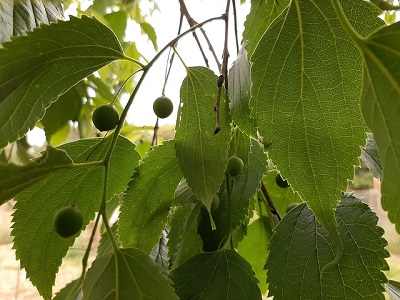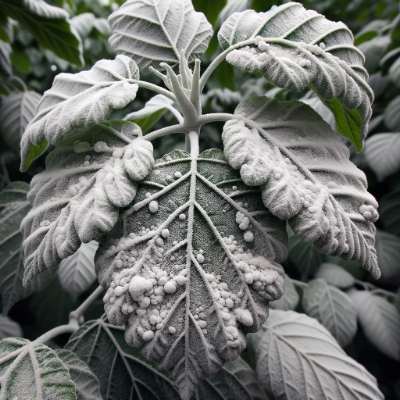Hackberry trees are renowned for their toughness and durability, yet like any living thing, they are not impervious to problems. There are a few typical difficulties that may harm the health and look of hackberry trees even though they are generally free from insect and disease problems. Insect problems and two diseases that hackberry trees may experience are discussed in this article. You can safeguard the health of your hackberry tree and preserve its aesthetic appeal in your landscape by being aware of these problems and knowing how to spot and take care of them.
Common hackberry tree problems include insect issues such as hackberry psyllids, aphids, and forest tent caterpillars. Hackberry psyllids produce leaf galls but do not hinder the tree’s development. Aphids may destroy ornaments and leave behind a sticky substance. The tree loses its leaves due to forest tent caterpillars, but it may grow back. Hackberry trees may develop witches’ brooms, which are aberrant growth patterns but not hazardous. A fungal condition known as Armillaria root rot may cause root deterioration and tree mortality. Even though hackberry trees are often free from concerns, being aware of and resolving these problems may help preserve the health and beauty of the tree.
Insect Problems
| Insect Problems | Description |
|---|---|
| Hackberry Psyllid | Common problem causing galls on the underside of leaves. Primarily cosmetic, not harmful. |
| Aphids | Sap-sucking insects that can cause ornamental damage and leave sticky residue (honeydew). |
| Forest Tent Caterpillars | Defoliating caterpillars that can temporarily weaken the tree but usually recover. |
1. Hackberry Psyllid
The most frequent insect issue that hackberry trees deal with is the hackberry psyllid. On the underside of hackberry leaves, these small insects deposit their eggs, which results in the development of galls. Galls are abnormal growths that show up on the leaves as lumps or swellings. Despite their unsettling appearance, hackberry psyllid galls do not harm the tree’s development or general health. They are more of an annoyance in terms of appearance. The galls may range in size and hue from red to green.

Identifying Hackberry Psyllid Infestation
Examine the undersides of your hackberry tree’s leaves carefully to see whether psyllids are present. Keep an eye out for the existence of galls, which are often more obvious in the summer. If you discover galls, your tree most likely supports a population of hackberry psyllids.
Treatment and Prevention
Fortunately, infestations of hackberry psyllid don’t usually call for any action. The tree’s general health is unaffected by the galls, which are purely aesthetic in nature. If the presence of galls disturbs you, you may manually remove the afflicted leaves or think about using pesticides that have been particularly formulated to combat psyllids. When using any chemical treatments, be sure to adhere to the manufacturer’s directions and suggestions.
As an Amazon Associate we earn from qualifying purchases.
Table of Contents
2. Aphids
Hackberry trees may get infected with aphids, a common insect that feeds on sap. By eating on the leaves of the tree, these microscopic parasites might harm decorative items. On the undersides of leaves, they often assemble in dense clusters. A sticky, sap-like material called “honeydew” is excreted by aphids after feeding. The formation of a black fungus known as sooty mold, which lessens the aesthetic value of the tree, may be caused by the presence of honeydew.
Identifying Aphid Infestation
Look closely at the leaves of your hackberry tree for groups of tiny, soft-bodied insects to identify aphids. The honeydew that the aphids left behind may also appear as a glossy or sticky coating on the leaves. Additionally, keep an eye out for the growth of sooty mold, which coats the leaves with a black covering.
Treatment and Prevention
On hackberry trees, controlling aphids naturally is often possible. Encouragement of benevolent insects like ladybugs or lacewings may assist in controlling aphid numbers. To get the aphids off the afflicted foliage, you may also try spraying a vigorous stream of water on it. The use of horticultural oils or insecticidal soaps as a targeted therapy is possible in extreme situations. Make sure you adhere to the directions on the product’s label and take the appropriate safety measures to prevent injuring helpful insects or pollinators.
3. Forest Tent Caterpillars
Another insect pest that may harm hackberry trees’ ornaments is the forest tent caterpillar. These caterpillars are defoliators, which means they eat the tree’s leaves, causing the foliage to wither. Although temporary tree weakness may result from defoliation, hackberry trees often bounce back and grow new leaves.
Identifying Forest Tent Caterpillar Infestation
Look for clusters of black, hairy caterpillars while checking your hackberry tree for an infestation of forest tent caterpillars. Their characteristic white keyhole-shaped patterns on their backs make these caterpillars easily identifiable. If the infestation is bad enough, you can also see a major drop in foliage density.
Treatment and Prevention
Forest tent caterpillars often don’t affect hackberry trees over the long run. The best course of action is to let natural predators like birds and parasitic wasps manage the number of caterpillars. However, if the defoliation is severe or persistent, you could think about using pesticides like Bacillus thuringiensis (Bt), a biological insecticide that targets caterpillars, as a management tool. Once again, it is essential to strictly adhere to the directions on the product label in order to guarantee efficient and secure application.

Disease Problems
| Disease Problems | Description |
|---|---|
| Witches’ Brooms | Abnormal growth formations throughout the crown of the tree, disfiguring but not harmful. |
| Armillaria Root Rot | Fungal disease causing root decay, potentially leading to the death of the tree if untreated. |
1. Witches’ Brooms
In the summit of certain hackberry trees, there are aberrant growth structures known as “witches’ brooms.” They resemble a broom because of the way they grow—clusters of tightly packed, little branches. Witches’ brooms may make the tree seem ugly, but they usually don’t impair the tree’s health in any way.


Identifying Witches’ Brooms
Look for tightly packed clusters of short branches that diverge from the hackberry tree’s usual development pattern to spot witches’ brooms. During the winter when the foliage has dropped, these brooms are often more visible.
Treatment and Prevention
Witches’ brooms often don’t need any care or removal. You may trim the brooms back during the dormant season to give the tree a more natural look if their aesthetic presence bothers you. To reduce the possibility of causing the tree more stress or problems, be careful while trimming and make sure to use the right procedures.
2. Armillaria Root Rot
Hackberry trees are susceptible to the fungus Armillaria root rot. If left untreated, it is brought on by the disease Armillaria mellea and may result in root degradation and ultimate tree death. The prevalence of this disease is higher in stressed or impaired hackberry trees.
Identifying Armillaria Root Rot
The signs of Armillaria root rot may not always be obvious, making detection difficult. At the tree’s base or close to the root collar, look for clues such as the presence of mushrooms or fungal conks. Observe the tree for signs of general deterioration as well, such as wilting, yellowing leaves, and dieback of limbs.
Treatment and Prevention
Keeping your hackberry tree healthy and vigorous will help prevent Armillaria root rot. Make sure you use the right planting methods, which include planting in soil that drains properly and avoiding deep planting. Avoid overwatering the area since it might encourage the development of fungi. Consult a qualified arborist for a precise diagnosis and suitable treatment options if you suspect Armillaria root rot.
Other Reported Problems
Other problems with hackberry trees have been documented, albeit they are less frequent. Among them are cankerworms, which are caterpillars that eat leaves, and island chlorosis, which is characterized by yellowing or chlorotic regions on the leaves. Even though these difficulties are less frequent than the previously mentioned insect and disease problems, you should nonetheless take care of them if they have an impact on the health or beauty of your hackberry tree.
FAQs
Is Hackberry a Good Yard Tree?
Hackberry trees can indeed be an excellent choice for yard trees. They have several desirable characteristics that make them suitable for urban landscapes. Hackberry trees establish easily and are known for their adaptability to different soil types and environmental conditions. They can tolerate various moisture levels, including periods of drought. Additionally, hackberry trees are relatively resistant to pests and diseases, making them low-maintenance options for homeowners. Their dense canopy provides ample shade, creating a comfortable outdoor environment. Moreover, hackberry trees are known to attract birds and other wildlife, adding to the biodiversity of your yard.
What is Killing My Hackberry Trees?
One common pest that can harm hackberry trees is the lac bug, also known as the hackberry nipple-gall maker (Tachardiella spp.). Lac bugs are small insects that create nipple-like galls on hackberry trees. These galls are caused by the feeding activity of the female lac bugs. While the galls themselves are not usually harmful to the tree’s overall health, severe infestations can weaken the tree and make it more susceptible to other stressors. If you suspect lac bug infestation, it is advisable to consult with a professional arborist to determine the best course of action for treatment and tree health management.
What is a Common Hackberry Tree Good For?
Hackberry trees serve several beneficial purposes, making them valuable in various settings. One notable advantage of hackberry trees is their ability to provide good cover. The dense foliage and branching structure of hackberry trees create a suitable habitat for birds, squirrels, and other small animals. They offer protection from predators, nesting opportunities, and a food source through the small fruits they produce. Hackberry trees also contribute to soil stability, erosion control, and the improvement of air quality in urban environments. Additionally, hackberry wood is often used for making furniture, cabinetry, and other woodworking projects due to its strength and durability.
Why Do People Hate Hackberry Trees?
While hackberry trees have numerous positive attributes, some people may have reservations about them. One reason for the dislike of hackberry trees is their bark, which is often described as “funky-looking.” The bark has a rough, cork-like texture with pronounced ridges and furrows. While some appreciate its unique appearance, others may find it less visually appealing compared to other tree species with smoother or more visually striking bark. It’s worth noting that personal preferences for tree aesthetics can vary widely, and what one person dislikes, another may appreciate.
Conclusion
Despite the fact that hackberry trees are often hardy and comparatively resistant to insect and disease problems, it’s important to be aware of the typical problems that might occur. Knowing the warning signs, symptoms, and remedies for hackberry psyllids, aphids, forest tent caterpillars, witches’ brooms, and Armillaria root rot can help you maintain your hackberry tree’s health and aesthetic appeal for years to come. You can keep a hackberry tree healthy and productive for many years by keeping up with regular monitoring, doing correct care, and acting quickly when required. I hope you find this article “Common Hackberry Tree Problems” helpful.
Related Posts:
Hackberry Tree Pros And Cons – 10 Facts You Need to Know
Weeping Cherry Tree Problems: 25 Causes & Solutions Explained
9 Autumn Blaze Maple Problems and Solutions
6 Jade Plant Problems – How to Fix(Root Rot, Limp)
The information provided about common hackberry tree problems are referenced from the following sources:
https://communityenvironment.unl.edu/hackberry-0
https://homeguides.sfgate.com/hackberry-tree-problems-53754.html
https://hyg.ipm.illinois.edu/pastpest/200111b.html
https://extension.umn.edu/trees-and-shrubs/common-hackberry
https://www.ehow.com/info_8361145_hackberry-tree-problems.html
https://www.uky.edu/Ag/Entomology/treepestguide/hackberry.html
© 2024 Lotusmagus.com. All rights reserved. This content is protected by copyright. Visit Lotusmagus.com for more information.
